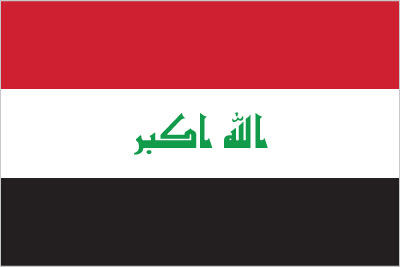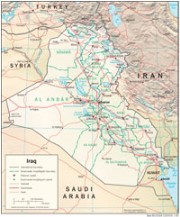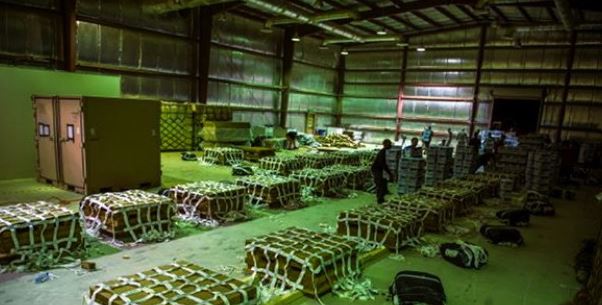 |
Iraq War News |
|
MenuHomeCurrent NewsBlogsGeneral InfoMapsConflict with ISISGulf War (OIF)OIRProvide ComfortDesert Storm
|
Aid to Yazidis Sect
The Yazidis on the mountain suffered from lack of shelter, water, and food. Many died on the mountain. Many more died leaving the mountain when, trying to escape, they fell into the hands of the Islamic State fighters. Airstrikes Against ISIL in Support of Yazidis Refugees. To keep the ISIL fighters at bay - preventing them from killing or capturing more Yazidis refugees - the U.S. conducted some limited air strikes in the Sinjar Mountain area. 1. Airdrop of Food and Water by U.S. The United States responded by dropping food and water in a number of successive airdrops using C-17s and C-130s. Unfortunately the first few air drops missed the mark and did not land in areas accessible to the refugees 4.; instead falling into the hands of the Islamic State fighters. Eventually some of the airdrops reached their destination. 2. The food being dropped by the aircraft are the "Meals Ready to Eat - Halal" or MREs. These MREs are acceptable meals for Muslims. 11. One of the lessons NOT learned by the Air Force from the Provide Comfort days is that pallets of water airdropped by parachute tend to break up and the water bottles burst. One reason why the Army pushed the air to discontinue the fixed-wing airdrops in favor of aid delivered by helicopter. Other Country Contributions. The Royal Air Force (UK) is reported 3. to have dropped relief supplies of food, water, and solar panels for recharging cell phones on Sinjar Mountain. How and Why Did Sinjar Fall So Quickly? There are a lot of unanswered questions about the Peshmerga's lack of zeal in trying to protect Sinjar and the ramifications of the quick withdrawal by the Kurds. Despite promises by the KRG that Sinjar was safe and an evacuation was not necessary, ISIL took the town almost without a fight and commenced to killing Yazidis men and enslaving Yazidis women. It appears that the Peshmerga force protecting Sinjar was not equipped with the proper weapons, were short on ammunition, and the strength of the force was minimal. In addition, the Kurds likely saw the Yazidis as "not Kurds" - and this could have affected their desire to fend off ISIL. According to some reports the Peshmerga stole away in the middle of the night without warning the Yazidis population. 13. The KRG most likely had more confidence in their Peshmerga and were not quite aware of the threat to Sinjar. Supposedly the Kurd leadership is mounting an investigation into the lack of defense for Sinjar. 14. The Yazidis do speak favorably about the Syrian Kurds who came to their rescue forming an escape corridor from the mountain to Kurd-controlled Syria. Syrian Kurds Help Save Yazidis. Syrian Kurdish fighters crossed the Syrian-Iraq border to come to the rescue of the thousands of Yazidis stranded on Mount Sinjar. They established a "land corridor" which the Yazidis could walk through to reach safety across the border in Syria. Once inside Syria they were brought to a hospital, settled into a temporary refugee camp where they received first aid, food, and water, or transported back across the border into Iraq so they can reach destinations in Kurdistan (Iraq). Most refugees were brought to the Syrian Kurdish town of Malikiya located 20 miles from the Iraqi border. In the midst of the Syrian conflict the Syrian Kurds have established a temporary area of self-rule in the northeastern corner of Syria. Syrian Kurds a Major Factor in Rescue of the Yazidis. The humanitarian drops of food and water by the U.S. and Britain - along with the air strikes against ISIL in the vicinity of Sinjar Mountain were important. However, the major factor was the movement of Syrian Kurd fighters from across the border into Iraq to take on ISIL on the ground and establising a land corridor for the evacation of the Yazidis off Sinjar Mountain. 15. Who are the Syrian Kurds? The Kurdish militias (also called "Local Self Defense Forces) that established the escape corridors for some of the Yazidis are a mix of militia groups; 10. but primarily from across the border in the area of northeastern Syria. One of the militia groups is known as the YPG - the armed wing of the Syrian Kurdish PYD party (associated with the PKK). 8.
On August 13 the U.S. stated that the Yazidis crisis was over. The trigger for this conclusion was a visit to the top of Mount Sinjar where military and USAID observers noted there were about 4,000 refugees but they had adequate supplies of food and water. President Obama stated that there was no need for a military operation to evacuate the refugees off the moutain.
August 2, 2014. The Yazidis start to flee the Islamic State fighters - leaving their homes in Sinjar and outlying villages. Many fled to Dohuk and Zakho while others went to seek refuge atop Mount Sinjar. August 7, 2014. Syrian Kurds crossed the border and established a "safe passage" corridor for the Yazidis to flee Sinjar Mountain to a temporary refugee camp in Kurdish ruled Syria. August 10, 2014. The U.S. conducted its fourth airdrop of food and water on Mount Sinar, Iraq. The airdrop was done by one C-17 and three C-130 cargo aircraft that dropped a total of 88 bundles of supplies. The C-17 dropped 40 container delivery system bundles of fresh drinking water (3,804 gallons) and the C-130s dropped 48 bundles (22,488 meals and 590 gallons of water). 5. August 11, 2014. The U.S. conducted a fifth airdrop of food and water on Mount Sinjar. One C-17 and three C-130s conducted the drop (76 bundles of supplies). 6.
August 13, 2014. A group of 20 Special Forces troops landed on top of Sinjar Mountain to assess the situation of the remaining Yazidis remaining. The troops determined that the displaced persons have plenty of food and water (as a result of U.S. and British airdrops). Some several thousand refugees remain - down from approximately 50,000 from a week ago. 9. The SF troops were transported via V-22 Osprey aircraft. Sinjar Retaken from ISIS. In November 2015 an alliance of Kurdish factions resulted in recapturing ISIL-held territory in Nineveh province - including Sinjar. The temporary alliance consisted of the KRG's Peshmerga, Kurdistan Worker's Party (PKK), the Syrian Popular Protection Unit (YPG), and Yazidi militias (YBS). 16.
Read news stories on the Yazidis of Iraq
|
Books about Special Operations Forces in Iraqhttps://bookshop.org/lists/sof-in-iraq We are an affiliate of Bookshop.org and will earn a small commission if you click through and make a purchase. |
|
|
All external sites open up in a new window. |
|


